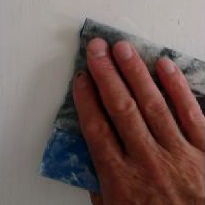





















Painting new plaster is not difficult however it is important that is it done properly otherwise there is a high risk of future problems particularly with cracked or peeling paint layers.
It is also unwise to paint a plastered surface that has not fully dried out, skim plaster layers over plasterboard do dry very quickly however surfaces which have been built up with bonding plaster and finished with a skim coat can take much longer to fully dry and should be left for at least 24 hours after the last visible signs of moister have disappeared. If the moisture content is difficult to gauge then use an electronic moisture meter and take multiple reading from across the surface.
When the plaster is fully dry use a large filling or scrapping knife to remove any plaster snots from the plaster surface and then remove all surface dust, a clean, soft bristled broom is a good tool for this job, be sure to wear a good quality dust mask.
Emulsion Paints Quick Instruction Page
It is essential that all new plaster is primed (Mist Coated) with either heavily diluted emulsion paint prior to applying any emulsion finishing coats; diluting emulsion paint for use as a plaster primer (Mist Coat) is straightforward. The recommended dilution rate for emulsion paint Mist Coats is on average 1 part clean water to 5 parts paint, however I find further dilution is often necessary.
Traditional Solvent Paints Quick Instruction Page
Plaster surfaces which are to be finished in traditional oil paints such as Eggshells and Glosses should be primed with an Alkaline Resisting Primer prior to the application of the finishing paint system.


